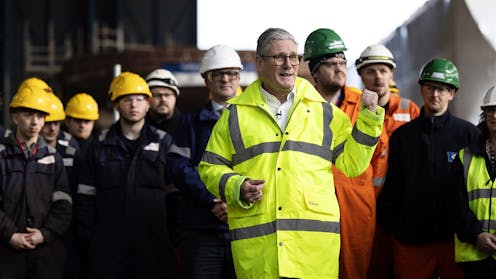In search of Labour’s ‘working people’ – the paradox at the heart of Keir Starmer’s first year in power
It’s one year since Keir Starmer led the Labour party to a landslide victory. Starmer’s manifesto, “Change” had proposed “securonomics” as a solution to the UK’s many crises. This was sold as a way of ensuring “sustained economic growth as the only route to improving the prosperity of our country and the living standards of working people”.
The document mentioned “working people” a total of 21 times. It was clear this demographic had been identified as the key target beneficiary of “securonomics”, otherwise referred to as “the plan for change”.
But there is a paradox at the heart of the proposal to deliver “change” to “working people” – one that helps explain the chaos of Labour’s first year in government. By obsessively pitting this demographic against “non-working people”, Labour is in fact not promising any real change at all.
Get your news from actual experts, straight to your inbox. Sign up to our daily newsletter to receive all The Conversation UK’s latest coverage of news and research, from politics and business to the arts and sciences.
One of the key premises of Labour’s securonomics is that growth must precede any significant investment. “Working people’s” priorities are therefore presented as being in line with that of a fiscally responsible state.
In the autumn budget, there was a pledge to “fix the foundations of the economy and deliver change by protecting working people”. To do this, the chancellor needed to fix a “black hole” of £22 billion in government finances.
The refusal to lift the two-child benefit cap, alongside “reforming the state to ensure […] welfare spending is targeted towards those that need it the most”, was framed as “putting more money in working people’s pockets”. There has, meanwhile, been a continued emphasis on encouraging those on benefits back to work.
Want more politics coverage from academic experts? Every week, we bring you informed analysis of developments in government and fact check the claims being made.
Sign up for our weekly politics newsletter, delivered every Friday.
Besides the clear deepening of inequality wrought by similar reforms in the past, welfare cuts make no sense on an economic or societal level. They undermine the economy, and the consequences put additional pressure on already underfunded social services.
As highlighted by the Office of Budgetary Responsibility (OBR), such cuts fail to deliver the promised behavioural change to force people into work. People instead become more focused on day-to-day survival.
Despite the government’s last ditch climbdown to save its flagship welfare reform policy its cuts are still forecast to push more than 150,000 people into poverty
Such reforms carried out in the name of “working people” perpetuate a pernicious myth of us v them. Not only are people in work also affected by these cuts but people’s lives – including their jobs, income, family situations, and health – shift regularly, making the “strivers v skivers” divide both simplistic and inaccurate.
Even “secure borders” and “smashing the criminal gangs” were positioned as “grown up politics back in the service of working people”. This association of working people with anti-immigrant attitudes links to a broader homogenisation of “working people” as both “patriotic” and in search of “security”. “Fixing the foundations” has been depicted in several social media posts as a patriotic act via use of the Union Jack.
Starmer meets ‘working people: steel category’.
Number 10/Flickr, CC BY-NC-ND
Meanwhile, stage-managed photoshoots of Starmer in factories with people wearing hard hats and hi-visibility jackets give a clear impression of the types of manufacturing jobs the government believes “working people” carry out. This gives an impressions that belies the reality of modern Britain – and an economy that is dominated by the service sector,, not manufacturing or building.
Old wine in new bottles
While Starmer framed his “plan for change” as a break with previous administrations, his “working people” narrative betrays this claim as anything but.
The idea that the deserving “working people” are different and separate from people who don’t (or can’t) work has been deployed by government after government to justify austerity and cuts to services. It has always been useful to separate the “scroungers from the strivers” and there is no sign of Labour changing course.
Hello! Are you working people?
Number 10/Flickr, CC BY-NC-ND
The term “working people” also builds on a previous trope of the “hard-working family”.
While initially coined by New Labour, this term has roots in Margaret Thatcher’s idea of the family, rather than the state, as the locus of welfare. It was not for the state to take care of you but your own kin.
Like “working people” now, “hard-working families” were those who played by the rules and knuckled down to earn a living. Previous Conservative administrations have depicted “hard-working families” as burdened by the unemployed, the poor, the sick and disabled and immigrants.
Add to this, the signalling continues to imply that the “authentic” working class of Britain are solely white – sometimes also male – and typically older, manual labourers, who are assumed to hold socially conservative views. This is another divide-and-rule trope which neglects the reality of the multiracial and multiethnic composition of the working classes.
In light of all this, any real “change” promised in Labour’s manifesto has been betrayed by a continuity with tired and damaging tropes of deserving and undeserving people. This is contributing to the sense, a year in, that this Labour government is merely repeating past government failures rather than striking out in a new direction.
George Newth works for University of Bath and is a member of the Green Party



